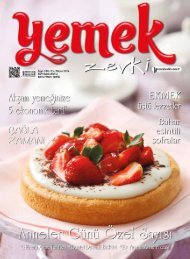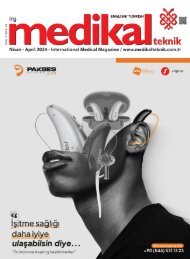Tekstil Teknik October 2020
Tekstil Teknik October 2020
Tekstil Teknik October 2020
- No tags were found...
You also want an ePaper? Increase the reach of your titles
YUMPU automatically turns print PDFs into web optimized ePapers that Google loves.
36 İNCELEME
Sıkma davranışı ve flote değişimi açısından
her kumaşın kendine has özellikleri vardır.
Kumaş cinsi, makine hızı, uygulanan reçete
ve emprenye ünitesi gibi tüm faktörlerin
biraraya gelmesi, emdirme teknesi içinde
belirli bir “tepki süresi” içinde “kimyasal
denge” ile sonuçlanacaktır. Bu tanımda
Kimyasal Denge; kumaş cinsi, sıkma oranları,
makine hızı vb. diğer tüm parametreler
sabit kalmak koşulu ile, bir emprenye sisteminin
emprenye flotesinde nihai ve sabit
bir konsantrasyona ulaştığı durum olarak
adlandırılır. Tabii ki konsantrasyonda küçük
değişiklikler olacaktır, ancak bu değişimler
ihmal edilebilir ve normaldir. Yalnızca
önemli değişiklikler olduğunda, örn. sıkmada
basınç kaybı, kumaş değişimi, dozaj
pompası arızası gibi durumlarda emprenye
konsantrasyonunda değişiklik gözlenebilir.
Tepki süresi ise, dengede olmayan bir emprenye
ünitesinin (makinenin yeni çalışmaya
başlaması, su/kimyasal sıkma oranlarında
değişim, çalışılan kumaş cinsinin değişmesi
gibi anlarda) kimyasal dengeye ulaşması
için gereken süre olarak tanımlanır.
Kimyasal Denge
Bir emprenye ünitesindeki konsantrasyon,
R in [ml/kg] the recipe (of H2O2)
Q1 in [l/kg] the amount of water on the fabric
before entering the impregnating system
Q2 in [l/kg] the amount of liquid on the fabric
leaving the impregnating system
∆Q in [l/kg] the application difference (Q2-
Q1)
f
the exchange factor, the
amount of water exchanged by the impregnating
liquid during impregnating as a numeric value
between 0,0 and 1,0
V in [l] the volume of the impregnating
unit: total amount of liquid, including mixing vessel
and piping.
Epu in [l/kg] effective pick-up (Epu =Q1*f+∆Q
where ∆Q=Q2-Q1)
Ct in [ml/l] the concentration in the impregnating
unit at a time t
C∞ in [ml/l] the concentration in the impregnating
unit at equilibrium (time t=∞)
C0 in [ml/l] the concentration in the impregnating
when applying new parameter (start of a
new production, change of fabric etc..) for t = 0
CF in [ml/l] the concentration of the feeding
liquid. (CF is the concentration of the sum of water
and chemicals leading to the impregnating unit.
Not to confuse with the amount of the feeding
liquid (which is identical to the add-on).
TEKSTİL & TEKNİK | EKİM | OCTOBER | 2020
zamana bağlı olarak, formül ile ifade edilebilir.
Ct emdirme flotesinin (t) zamanındaki konsantrasyonu
ve
C0 emdirme flotesinin (0) zamanındaki
konsantrasyonu
(t) birimi [dk] olacaktır.
Efektif pick-up (Epu), istenen reçete (R) ve
hacim (V) parametreleri üretim sırasında
sabit ve değişmeden kalır.
Emrenye ünitesindeki kimyasal konsantrasyon
dengeye kesinlikle t = ∞ ‘da ulaşılır. Bu
bu kısım aşağıdaki gösterildiği gibi sıfıra eşittir
The squeezing values, respectively application
amounts of the liquid on the fabric will have the
unit [l/kg]. It is known that the common term for
squeezing values is % and very often this nomination
will still be used for simple explanations but to
avoid mistakes in the formulas used in this paper
we will have to use the correct unit in [l/kg].
Every fabric will have its own characteristics in
view of squeezing behaviour and exchange. The
combined action of fabric, speed, applied recipe
and impregnating unit will result in a specific
“equilibrium” and “responding time”.
The equilibrium is called the situation where an impregnating
system is reaching a final and steady
concentration in the impregnating liquid whereas
all other parameter as fabric, squeezing, speed
etc. remains unchanged.
Of course there will be minor variations in the
concentration, but these variations are negligible
and normal. Only when substantial changes are
happening, as e.g. pressure loss in the squeezing,
different fabrics in view of exchange of fabric,
dosing pump failure etc… variation in the impregnating
concentration can be observed.
The responding time is defined as the time needed
for an impregnating unit to find again to an
equilibrium in case of a not adapted concentration
in the impregnating bath, as e.g. the start
of a unit, changes in the water and/or chemical

















